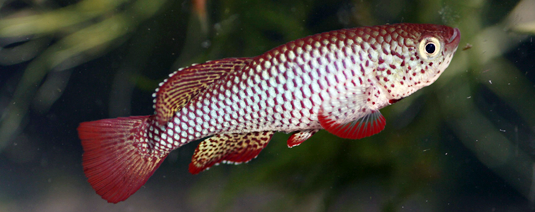Stone chronicles
The first detailed study of the otoliths of extant African annual killifish species provides vital information that will facilitate the identification of fossil forms of this group and contribute to the elucidation of their evolutionary history.
24.11.2014

Source: Dr. Martin Reichard
When the rains return, the annual killifish of the African savannah come to life again. These small and brightly colored species survive the rigors of the dry season as dormant embryos, and develop into the adult form in the ephemeral water bodies that dot the landscape in the rainy season. Indeed, such ponds can harbor up to four different species of the same killifish genus at once. “This is quite unusual, since very closely related species seldom occupy the same restricted habitat,” says LMU paleontologist Bettina Reichenbacher. Together with her colleague Martin Reichard (Czech Academy of Sciences), Reichenbacher has taken advantage of this atypical situation to determine whether the different species found in such ponds can be distinguished by the shapes of their otoliths.
A key for identification
Otoliths (‘ear stones’) are structures made up of the mineral aragonite embedded in a matrix of proteins, and function as balance organs in the inner ear of modern bony fish. Strikingly, the otoliths of many fish have such a highly characteristic form that they can serve as identification tags for individual species. Moreover, this is often the case even for very closely related species, which can otherwise be distinguished only on the basis of differences in pigmentation. In addition, because of their small size, otoliths of fossil fish are often preserved in cases where no other skeletal elements survive, and therefore serve as important palaeontological indicators. This explains why they play such an important role in the investigation of the evolutionary history and biodiversity of modern bony fish.
As a professor or paleontology, Bettina Reichenbacher turned to the otoliths of extant species of annual killifish with the intention of closing a gap: “Not a single fossil annual killifish has yet been described,” she says, “and this may be because no studies of the otoliths of modern annual killifish species have been done. This gap in our knowledge may well be responsible for the lack of reports on fossil annual killifish. – It is quite possible that such remains have been found, but have not been recognized for what they are.”
Otoliths as records of phylogeny and ecology
To a certain degree, otolith morphology also reflects the influence of environmental variables. Factors such as currents, temperature and the abundance of nutrients and minerals come into play here. On the one hand, this adds to their value, since it allows one to draw inferences about the habitats occupied by fossil and modern fish. But it also means that, if one wants to use otoliths for species identification and analysis of phylogenetic relationships, one must be able to screen out the effects of environmental variables. “And our study now shows that the otoliths of different East African annual killifish species can be clearly distinguished from one another, even when the samples come from the same pond. The genetically determined differences have a greater impact on otolith morphology than do the homogenizing effects of a shared environment,” Reichenbacher says.
So the new findings establish a framework which will enable researchers to classify the fascinatingly diverse annual killifish on the basis of their otoliths, and will greatly facilitate reconstruction of their evolutionary history. This is of particular interest because annual killifish also serve as important model organisms in aging research. And perhaps, fossil specimens of the ancestors of today’s annual killifish will soon come to light: Reichenbacher now intends to apply her new insights to the study of fossils found in Spain which, she suspects, may include the remains of some 6-million-year-old annual killifish.





